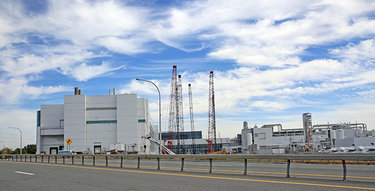Albany County had chart-topping surge in new business applications
The Enterprise — Michael Koff
The Albany Nanotech Complex is the headquarters of NY CREATES (Center for Research, Economic Advancement, Technology, Engineering, and Science), which acts as a connective tissue between public, private, and academic entities to further research and development in the high technology sector — most notably semiconductors.
ALBANY COUNTY — The number of new business applications submitted within Albany County grew by a third last year, putting it first in the state and in the top 10 percent nationally, according to data from the United States Census Bureau.
Last year’s growth compounds an unprecedented increase in applications that the county saw in 2021, when the number jumped 63 percent. Altogether, it makes for a 130-percent increase from 2020 — running from 3,841 applications that year to 8,859 in 2023.
The growth in that longer timeframe puts Albany County at the 83rd fastest growth in the country across more than 3,200 counties, and 4th fastest when looking at counties that had more than 1,000 applications in 2023.
According to Kevin O’Connor, the chief executive officer of the Advance Albany County Alliance, the surge is due to a number of factors that mostly feed into a central phenomenon: reshoring of manufacturing jobs that the United States had been outsourcing for decades.
“This is quite an unprecedented increase in new business formations …,” O’Connor told The Enterprise this week, “I think some of this is reflective of the pandemic, but not entirely so.”
It’s true that the number of new-business applications has grown substantially in most places, as O’Connor acknowledged, after the COVID-19 pandemic opened up new markets that were quickly flooded by entrepreneurs, who, in many cases, were seeking to replace their previous jobs during the upheaval.
But that alone doesn’t explain why Albany County did especially well.
O’Connor said he was recently at a SelectUSA conference, hosted by the federal Department of Commerce, where much was made of manufacturing jobs coming back to the United States after a decades-long trend of losing those jobs to other countries where labor is cheaper and regulations looser.
Lately, though, because of the pandemic and other factors, “It’s not been as attractive a financial situation,” O’Connor said, “and with the geopolitical risk involved, especially with China, a lot of Western countries have been moving their manufacturing back to the U.S. and other Western countries.”
He said that’s evident locally “particularly with the offshore wind guys that are mostly European and Asian companies that are coming in.”
According to the Massachusetts Institute of Technology’s Sloan Management Review, spending on U.S. manufacturing facilities rose to $114.7 billion in 2022, primarily in favor of those producing electrical equipment, appliances, and components; computer and electronic products; chemicals; transportation equipment; and medical equipment and supplies.
Albany County, home to Plug Power and the Albany Nanotech Complex, has presence in at least two of these top categories that belong to what the review called an “early-stage Renaissance.”
While they’re not examples of reshored businesses, O’Connor explained that already-existing entities like these still benefit from manufacturing-sector growth because that sector shares a root system, which also taps into other economic areas in the county.
“Manufacturing, they say, is a high economic-multiplier activity,” he said, “meaning it spins off a lot of other economic activity in its wake … As manufacturing has increased in the county, I think it’s given way to a whole series of other needs that have been filled by people starting up new companies, whether they be restaurants or retail stores or supply companies to support these manufacturers here.”
Semiconductor manufacturing in particular has seen a boost thanks to the CHIPS (Creating Helpful Incentives to Produce Semiconductors) and Science Act, which made that industry a priority for national security purposes, O’Connor said.
Of course, a rise in business applications doesn’t necessarily mean an equal rise in new businesses, and, unfortunately, it’s a hard figure to track down.
O’Connor said that a survival rate of about half “probably isn’t far off, from what I’ve read in the past,” but that the increase in new applications still outlines a “real phenomenon.”
When asked if he’s noticed any tangible changes in the county amid this meteoric rise in applications, O’Connor said that, anecdotally, “we’ve seen some very cool companies opening up.”
Among them: Boozy Moo! in Voorheesville, which makes alcohol-spiked ice cream, and Ecovative, which makes mushroom-based food and packaging products, among other things, and “employs some 200 people in Albany County,” he said.
To sustain business growth, O’Connor said that the county has launched the Sustainable Technology and Green Energy Grant Program. Advance Albany County Alliance, which is affiliated with the county, also administers the Al Tech Loan Fund, helping to finance local economic development opportunities.
At the municipal level, O’Connor said, towns and cities can “make sure they have the appropriate zoning and land-use planning for businesses to operate in, and to have a property-tax structure that works for a particular business.”
Once the appropriate environment has been established, O’Connor said that, like what’s being seen with manufacturing, business should beget more business.
“In the region, we’ve got the largest density of business activity,” he said, “so that kind of stimulates itself. There’s a self-regenerating effect that that has.”



